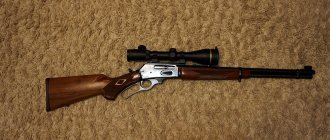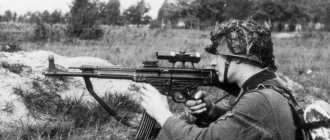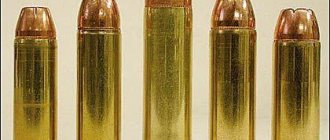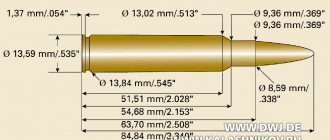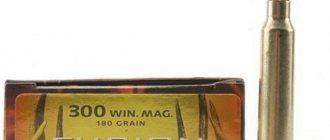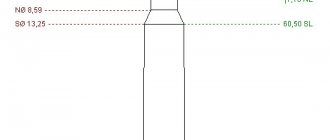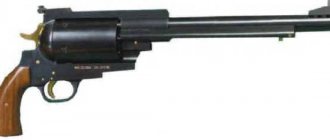History of the caliber: .375 Holland & Holland Magnum - a big cartridge for big hunting
More than a hundred years ago, the British created a new cartridge for one of their favorite national hobbies - safari, since then it has become not only universal, but also indispensable among hunters around the world
"This is a Bland's .577 axite express," he said. "I got that big fellow with it." He glanced up at the white rhinoceros. "Ten more yards, and he'd have added me to HIS collection."
Few fans of Conan Doyle's work would be able to immediately recognize this phrase. Alas, the translators of The Lost World were hardly avid hunters like Lord Roxton, so the description of the double-barreled shotgun (express, as it was then called) of the famous London company Thomas Bland & Sons of .577 caliber left them indifferent and, when translated into Russian, turned into a nondescript and an incomprehensible “hood”.
Meanwhile, it was these double-barreled monsters that became the favorite weapon of British gentlemen for hunting in Africa at the end of the 19th century. As they joked then, the duel was fair: when fired from such a gun, the hunter and the elephant fell at the same time, the winner was the one who was able to get up.
But in the new 20th century, they dared to challenge the British lion not only on the seas. In 1905, German gunsmith Otto Block developed the 9.3x62mm Mauser cartridge. It was easy to adapt the relatively inexpensive and reliable Gewehr 98 to it. At the same time, the new cartridge was better suited for large African game, and its “non-military” origin reassured the British colonial authorities, who had not yet forgotten the “Mauser bullets” with which the Boers famously punched holes in the red uniforms of the British soldier .
Of course, 9-mm magazine rifle bullets did not have the monstrous stopping or even knockdown power of large-caliber “express” rifles. But the practice of hunting, including the “African Big Five” - elephant, lion, leopard, buffalo and rhinoceros - has shown that successful hits “on the spot” are quite enough for these large and dangerous animals. The famous Scottish hunter Walter “Karamojo” Bell generally used either a 7x57 mm Mauser or even a 6.5x54 mm paired with an Austrian Mannlicher-Schönauer rifle - and a man who killed more than 1000 elephants during his career can hardly be called a bad hunter. In addition to the weight of the rifle, and this is a very important factor when you have to walk mile after mile across hot and dusty Africa for each animal, the deciding factor for many was the price. Mausers and Mannlichers, even in hunting versions, were versions of army rifles produced in large series. British hunting double-barreled shotguns were the result of handcraft. And not everyone could afford to get the result of this work into their weapons cabinet.
Willy-nilly, British gunsmiths also had to join the “rifle race”. In particular, some researchers believe that it was Westley Richards who jointly created the .375 Rimless Nitro Express cartridge, which became known as the 9.5x57 mm MS. We approached the issue in even more detail. Their new ammunition was designed to perform as reliably as possible - primarily in feeding - in repeating rifles. The cartridge turned out to be long, to ensure low pressures while maintaining a high bullet speed - the cordite gunpowder used in the original cartridges, firstly, had long threads, and secondly, it was sensitive to temperature, giving in the hot African climate increased pressure that could dangerously inflate the cartridge case . Reliable extraction should also be ensured by the shape of the sleeve with a large taper. Finally, an important innovation was the groove band, which later became a signature feature of many hunting magnums.
However, with all the advantages of the new cartridge that appeared in 1912, it could well remain “widely known in narrow circles.” But someone in the management of “Holland and Holland” came up with an extremely successful idea - to make what programmers now call “open source” - by publishing the specification of their new cartridge and allowing the free production of weapons for it. Perhaps this would not be enough for more than a century of popularity. But there were also external factors added. The First World War and subsequent Versailles restrictions effectively removed German competitors from the market. But Americans began to show interest in traditionally British entertainment. True, their favorite .30-06 for large African game seemed rather weak, especially considering the habit of animals from the “Big Five” to rush at the hunter when wounded. In search of the best “stopper,” the Yankees turned to experts on the subject from the former metropolis. In 1925, Winchester produced the first rifle for .375 H&H, and other manufacturers followed suit.
The success of the “Dutchman” was finally consolidated after the Second World War by new safari rules. As hunting magazines delicately put it, “British authorities are tired of sending home the remains of people who tried to hunt large dangerous animals with unsuitable weapons.” Today, in all countries where hunting for the “African Big Five” is allowed, the minimum caliber is established by law and usually the .375 Holland & Holland Magnum tops the list. In addition, unlike the more powerful elephant killers, the .375 H&H has proven itself over the past hundred years to be a fairly universal cartridge, suitable not only for the “hot yellow of Africa in its central part,” but also for large game in more northern latitudes. True, its ballistics are not suitable for mountain hunting, but at a distance of 30 to 300 meters, few can argue with the .375 H&H.
Well, if you’re planning to go to Africa, you definitely won’t be able to live without it.
.375 H&H Magnum cartridge
Cartridge .375 Holland & Holland Magnum, 1912, UK
Tactical and technical characteristics of .375 Holland & Holland Magnum
Caliber, mm - .375 (9.5×72) Cartridge length, mm - 91.44 Case length, mm - 72.39 Case flange diameter, mm - 13.51 Case diameter at the collar , mm — 13.03 Case diameter at the slope, mm — 11.37 Case neck diameter, mm — 10.21 Bullet leading part diameter, mm — 9.53
The legendary .375 Holland & Holland Magnum (originally the .375 Belted Rimless Magnum) was developed in Great Britain by Holland & Holland in 1912 and was intended for hunting large African game.
It was with the advent of the .375 H&H Mag cartridge and its distribution that the term “Magnum” gained worldwide fame, and Holland & Holland became the founder of a new type of ammunition with excellent ballistics and original design.
.375 Holland & Holland Magnum
The main advantage of the .375 H&H cartridge was its exceptional accuracy. Thus, in test shootings, the cartridge invariably demonstrated accuracy of the order of one minute of arc, which corresponds to a dispersion diameter of 2.5 cm at a distance of 100 m.
Initially, the cartridge was produced in two versions: with a flanged casing for firing from double-barreled fittings, and with a wafer casing for repeating rifles. The wafer sleeve near the very bottom received a special thickening belt, which played a dual role: firstly, the strength of the structure was further enhanced, and secondly, the belt actually acted as a flange in the wafer sleeve, ensuring its precise fixation in the chamber and reliable pinning of the primer.
Subsequently, such a belt became an indispensable attribute of most high-power magnum cartridges. The domestic industry has never produced ammunition of this kind, so there is no special technical term in Russian for cartridge cases with a belt. In English they are called Belted cases - cartridge cases with a belt. The flanged version of the cartridge was gradually abandoned.
In general, the .375 H&H is not a cartridge for long-range shooting, although it can accurately hit at a distance of 300 m. The recoil of weapons chambered for the .375 H&H can be described as very heavy. It is about 75 J and is carried 2.5 times heavier than the 7.62x54R cartridge.
In the 1900-1910s, a number of excellent ammunition for African hunting appeared, the power of which exceeded the .375 H&H. However, all of them remained purely African relics, while the 375th gained a huge number of admirers on all continents for hunting a wide variety of large and dangerous animals.
Gradually, sales of the .375 H&H Mag cartridge and weapons for it gradually decreased. But later, interest in the cartridge began to grow again, and many companies began to produce weapons for it. Both advertising and past fame played a certain role in this, since the cartridge is by no means universal. Indeed, although the cartridge is not very expensive, for a medium-sized animal its power will be overkill, and for African safaris it is rather weak by modern standards.
.375 H&H Mag
The cartridge is very popular to this day, although by modern standards its energy of about 6 thousand J is considered not quite sufficient for hunting elephants, hippos and large African buffalos. But this popularity is more likely not commercial, but informational: the cartridge is mentioned in a huge number of books, reference books and websites on the Internet.
In foreign reference books, the .375 Holland & Holland Magnum cartridge is considered the absolute minimum for hunting dangerous animals in Africa, and it is immediately recommended to choose really “heavy” calibers, for example .416 or more. Sometimes it is called the “lion cartridge”, but professional hunters when hunting this predator always have a large-caliber weapon (.450 - .600) as a backup, capable of “short-term” stopping the attack of any dangerous large animal.
For those hunters who go hunting in Africa without their own weapons, the host company and a professional hunter in 90% of cases will provide a carbine chambered for .375 H&H, since it is the main tool for everyday hunting there.
.375 H& Mag
The production of .375 Holland & Holland Magnum cartridges was established in England, Germany, Sweden, the USA, and weapons chambered for this cartridge were produced by various companies: Mauser, Griffin & Howe, Winchester, Remington, Sako, Steyr - Mannlicher, Mannlicher - Schonauer and others.
The .375 Holland & Holland Magnum cartridge is designated: .375 H&H Magnum / .375 Holland & Holland / .375 Holland & Holland Magnum Belted / .375 Belted Rimless Magnum H&H / DWM 639 / SAA 6105 / 9.5 x 72 mm / XCR 10 072 BFC 010.
Sunday, December 1
.375 H&H Magnum. Why is this rifle cartridge called the “Great African Caliber”? Advantages and disadvantages.
“From Africa to Alaska, this truly legendary cartridge can be used to kill almost any creature that roams the Earth. At the words “375 Holland-and-Holland”, the blood of a real man begins to boil. These words awaken the romance of adventure in the soul, and pull you to distant and wild lands, where a hunter at any second can be killed, crushed or torn apart by a wounded monster..."
Claire Rees.
The characteristics of this ammunition were simply excellent for its time. However, progress has gone far ahead over more than 100 years. And the .375 H&H Magnum cartridge remains the “king of African hunts.” This means that the advantages of the cartridge more than offset its disadvantages.
“Promoted” and “legendary”. I must say that the cartridge is already quite outdated. However, legislative restrictions in countries where commercial safari “feeds” part of the country’s population, this caliber is defined by law as minimal. Consequently, a hunter who comes on safari without his own weapon will most likely be provided with a carbine in .375 H&H. This happens, for example, if a hunter flies in transit with a stopover in the UK, whose laws allow the confiscation of any weapon, even a declared hunting weapon. But you also need to be able to shoot with a large-caliber carbine! And not just be able to shoot, but shoot regularly! So Afrikaner hunters buy “homemade” weapons chambered for this particular cartridge. They study, “get their teeth into” and regularly “refresh” their weapons skills. African hunting is dangerous entertainment. Africa does not forgive carelessness.
High trajectory flatness, inaccessible to larger calibers. No, in order for the trajectory of a heavier bullet to be the same, you can pour more gunpowder into the cartridge case; weapons and modern cartridge cases will withstand such a “mini-explosion”. But the man, no. A recoil of 75 Joules is considered critical for a person of average build. Guess what the average recoil is for a .375 H&H Mag? That's right, 75 joules. Here's what the all-knowing Wikipedia writes about this: “The recoil when firing .375 H&H Magnum cartridges is small compared to the recoil from other cartridges for hunting large game (which is another reason for the great popularity of this cartridge). This, however, does not mean that it is weak - an untrained shooter should exercise some caution."
